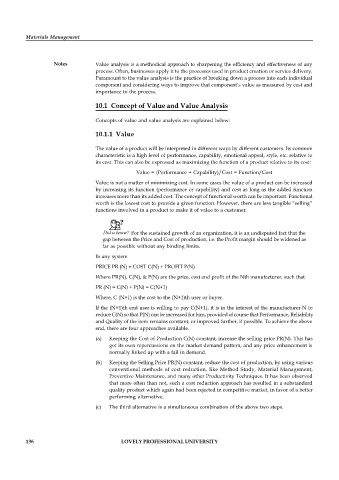Page 141 - DMGT525_MATERIALS_MANAGEMENT
P. 141
Materials Management
Notes Value analysis is a methodical approach to sharpening the efficiency and effectiveness of any
process. Often, businesses apply it to the processes used in product creation or service delivery.
Paramount to the value analysis is the practice of breaking down a process into each individual
component and considering ways to improve that component’s value as measured by cost and
importance to the process.
10.1 Concept of Value and Value Analysis
Concepts of value and value analysis are explained below:
10.1.1 Value
The value of a product will be interpreted in different ways by different customers. Its common
characteristic is a high level of performance, capability, emotional appeal, style, etc. relative to
its cost. This can also be expressed as maximizing the function of a product relative to its cost:
Value = (Performance + Capability)/Cost = Function/Cost
Value is not a matter of minimizing cost. In some cases the value of a product can be increased
by increasing its function (performance or capability) and cost as long as the added function
increases more than its added cost. The concept of functional worth can be important. Functional
worth is the lowest cost to provide a given function. However, there are less tangible “selling”
functions involved in a product to make it of value to a customer.
Did u know? For the sustained growth of an organization, it is an undisputed fact that the
gap between the Price and Cost of production, i.e. the Profit margin should be widened as
far as possible without any binding limits.
In any system
PRICE PR (N) = COST C(N) + PROFIT P(N)
Where PR(N), C(N), & P(N) are the price, cost and profit of the Nth manufacturer, such that
PR (N) = C(N) + P(N) = C(N+1)
Where, C (N+1) is the cost to the (N+1)th user or buyer.
If the (N+1)th end user is willing to pay C(N+1), it is in the interest of the manufacturer N to
reduce C(N) so that P(N) can be increased for him, provided of course that Performance, Reliability
and Quality of the item remains constant, or improved further, if possible. To achieve the above
end, there are four approaches available.
(a) Keeping the Cost of Production C(N) constant, increase the selling price PR(N). This has
got its own repercussions on the market demand pattern, and any price enhancement is
normally linked up with a fail in demand.
(b) Keeping the Selling Price PR(N) constant, reduce the cost of production, by using various
conventional methods of cost reduction, like Method Study, Material Management,
Preventive Maintenance, and many other Productivity Techniques. It has been observed
that more often than not, such a cost reduction approach has resulted in a substandard
quality product which again had been rejected in competitive market, in favor of a better
performing alternative.
(c) The third alternative is a simultaneous combination of the above two steps.
136 LOVELY PROFESSIONAL UNIVERSITY

